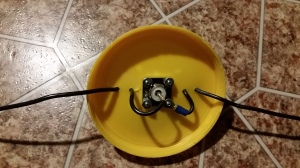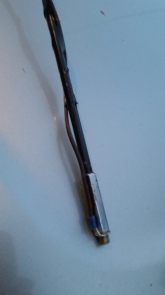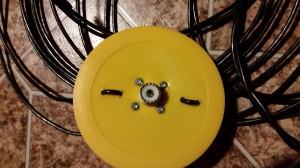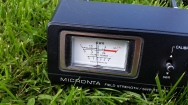 So now we are over the whole “CB radio is useless” thing and everyone wants to know what’s next. Well, we have acquired a cheap CB and we have acquired a power source : https://dialtoneblog.wordpress.com/2015/05/07/grid-down-power-up/
So now we are over the whole “CB radio is useless” thing and everyone wants to know what’s next. Well, we have acquired a cheap CB and we have acquired a power source : https://dialtoneblog.wordpress.com/2015/05/07/grid-down-power-up/
Now, we are missing one of the most important things. The antenna. Lets see what we can conjure up with what we have lying around. First, we could use a manufactured antenna but, we don’t have one. We are not that lucky. As a side note : My favorite manufactured antenna for CB (and some HAM radio applications) is a 102″ stainless steel whip with a heavy-duty spring. If you have a fiber glass whip, sometimes they break internally. No problem, we can repair that. Just tape wire up the side and use the whip as a form for the wire (see photo). OK, whats the plan? Lets go with something tried and true. It’s dirty dipole time! A dipole, for those not familiar, is a simple wire antenna that consists of two “legs” a center insulator (aka: cobra head), and feed line to your radio. Here is where the improvisation comes in. For the legs of the antenna you can use almost any kind of wire. You could use an old extension cord, speaker wire, CAT5, whatever you can scrounge. For this post I used a 15′, 16ga lamp extension cord.
These things are everywhere; check the Christmas light box. I separated the wire into two pieces and all is good. Your CB is low power (qrp) so the wire size is not that crucial. Your going to need about 18-20′ of wire for a CB dipole. That amount of wire would change if you are operating on different frequencies. I am not going to get into the math to make a dipole (though it’s not hard at all), that will be a different post. Now you will cut the wire into two equal pieces around 104″ each. Now we need a center insulator (AKA: cobra head). Get creative, almost anything non-conductive will work.  Enter mayonnaise jar lid. A lid from a mayo or peanut butter jar works great. If you have a so-239 connector (if your lucky) lying around, you can mount it in the middle of the lid. Then you drill (or poke) some strain relief holes for the wire Legs. Solder one leg to the center pin on the so-239 and the other leg to the case of the connector.
Enter mayonnaise jar lid. A lid from a mayo or peanut butter jar works great. If you have a so-239 connector (if your lucky) lying around, you can mount it in the middle of the lid. Then you drill (or poke) some strain relief holes for the wire Legs. Solder one leg to the center pin on the so-239 and the other leg to the case of the connector.
 Tie some cordage to each leg and hang it horizontal between to supports (trees, etc). Hook up coax and you’re good. Now wait, it’s time to get dirty……. No so-239, no center, no coax?? No problem……well it is a problem. Those things are very important. First, no center insulator. OK, take the lamp cord and split it until eachside is approximately 104″ long, then tie a knot.
Tie some cordage to each leg and hang it horizontal between to supports (trees, etc). Hook up coax and you’re good. Now wait, it’s time to get dirty……. No so-239, no center, no coax?? No problem……well it is a problem. Those things are very important. First, no center insulator. OK, take the lamp cord and split it until eachside is approximately 104″ long, then tie a knot.
The knot keeps the wires from separating. You just made a field expedient cobra head. Now, If you have coax you can solder or wire nut the coax to the wires. One side to the coax shield and the other side to the coax center. Careful not to short anything out. I also have used 75 ohm cable TV coax for this. Does it work as good as rg58 or rg8x? No, not nearly as good, but it gets you on the air when nothing else is available. The SWR using 75 ohm coax was ugly but it keeps you’re “outta the red”. If you are making this antenna you have no time to worry about SWR. Someone is going to tell you not to use 75 ohm coax and they are right. We are talking dirty, no rules, rip that TV coax out of the wall and get comms up! Now we are going to get real desperate. No coax at all. OK as a last-ditch effort to get things going, we will make “jungle coax”. The same wire we used to make legs, we will also use to make feed line. Take the feed line wires and make a twisted pair. Twisting the wire makes the difference.
When put on a SWR meter, the twisted pair performed better than 75 ohm coax. Once again, does it work good? No. Does it work better the tin cans and string? Yes. All of these materials are available
everywhere. Practice now and work it out. I hope this makes you think outside the box. You are not going to “work the world” with this set up but you can get local communications online. Now go and do it! Dialtone OUT.

sky high








Pingback: Jungle Telegraph/Community Communications: Part II | Western Rifle Shooters Association
Reblogged this on Starvin Larry and commented:
Pay attention-go back and read Part I if not up to speed.
LikeLike
What kind of range is possible with a carefully fabricated and tuned antenna? Are their techniques to boost the range?
I have a buddy who is approx 20 miles line of sight, we are each on high elevation ridgelines. Im guessing but a standard el-cheapo CB/ CB antenna isn’t capable of that range right?
LikeLike
Well, if you have a good antenna (make one, it’s better) , if you get it as high as possible, and conditions are ok 20 miles can be possible. If you are on ridge lines you may be ok. You could look into a beam antenna. A beam for cb is large but if you both had them aimed at one another it would also work. Try it and let us know!
LikeLike
Ok that’s good info thanks. I have a lot to learn. But that is the fun part. Definitely have to do the dirty dipole.
Hey that is a good name for a dance…!
LikeLike
Pingback: KIT UP! | communications tradecraft